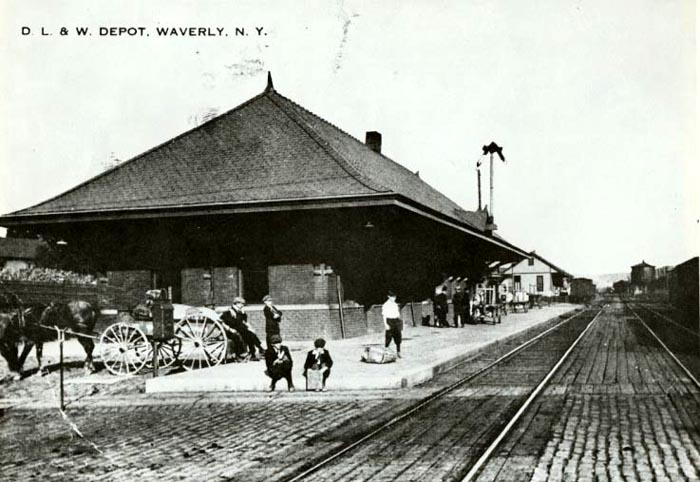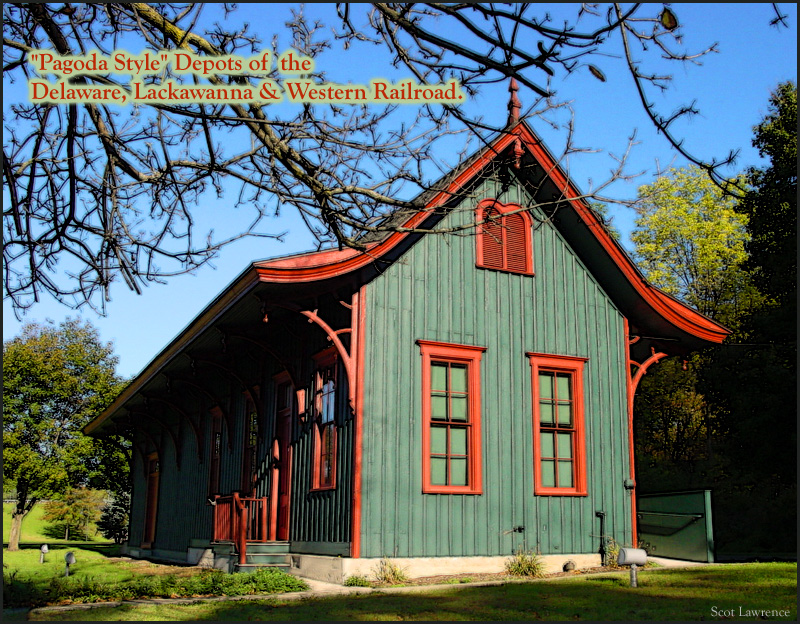|
When
exactly where
the Pagoda
depots
built?
At
first
glance, the
answer seems
obvious.."1881
and 1882"..
Since those
are the years
the DL&W
mainline was
built across
New
York state to
Buffalo. But
it might not
be that
simple!
As I mentioned
above, the New
Jersey depots
have different
details than
their New York
state
sisters..And
there is some
uncertainty
concerning the
build dates of
the NJ
depots..the
mere fact that
they have
different
details than
the
NY depots
would suggest
the NJ and NY
depots were
built at
different
times..but
which came
first?? Was
the Pagoda
pattern first
developed
for the New
York state
mainline
extension to
Buffalo,
making the
first
Pagoda depot
perhaps
Vestal, in
1883, then the
PA and NJ
depots came
later...or
were the NJ
depots built
first? then
the design was
"standardized"
for the
Buffalo
extension?
This is all
currently
unknown.
The
Vestal,
Apalachin and
Nichols, NY
depots, the
three
easternmost
depots
in NY, have
some design
features that
are unique
to them! and
appear on no
other Pagoda
depots..the
main detail
difference
being the
shape of the
roof brackets:
Vestal, Apalachin
and Nichols
depots:

Every other
New York
Pagoda depot
has a second,
different
bracket style!

This
suggests, to
me, that
perhaps
Vestal was the
"prototype"
pagoda depot,
built first,
with some
details
that were not
used on the
"final" design
for the rest
of the depots.
Also Vestal,
being the
Easternmost
Pagoda depot
in NY state,
would have
have had
active rails
earlier than
any other New
York state
pagoda
location, and
would have
been "ready"
for a depot
first.
DL&W rails
were in
service to
Vestal by the
spring of
1881.
But were
Pagoda depots
being
constructed as
the mainline
reached the
individual
communities in
1881 and 1882?
I would
naturally
assume
so..but
perhaps not..
I found some
details on the
build dates
for the
DL&W
across the
Southern Tier
of New York,
and some
interesting
details
concerning the
Waverly, NY
(non-pagoda)
depot
construction.
This
information is
from the book
"Twenty Five
Years at the
Junction,
1865-1889" by
Frank Evans of
Sayre, Pa. The
book was
published
around the
year
2000, and is a
detailed
account of the
Erie, LV and
DL&W
activity
in and around
Waverly NY and
Sayre PA
during those
formative
years.
September 1880
- DL&W
surveying
crews first
reach Waverly.
July 29, 1881
- DL&W
rails are
active to
Owego.
August 16,
1881 -
DL&W rails
reach Nichols.
October 14,
1881 -
DL&W rails
reach Waverly.
November 25,
1881 - a
DL&W depot
exists in
Waverly. (this
is the "first
depot".)
April 7, 1882
- Trains are
running to
Elmira.
August 10,
1882 -
DL&W is
open to Bath.
September 14,
1882 - The
DL&W
mainline is
complete to
Buffalo,
trains are
running over
the whole
system.
(freight only
to
Buffalo,
Passenger
service as far
as Mount
Morris)
February 25,
1883 -
Passenger
service now
also open to
Buffalo.
So thats
essentially
two years of
construction
to build the
DL&W
mainline
between
Binghamton
and Buffalo,
1881 and 1882.
The webpage
for the museum
in Painted
Post says
their depot
was built
"1881-1882"..
which seems
perfectly
logical given
the dates the
railroad was
built!
and assuming
the pagoda
depots were
built along
with the
railroad,
since the
communities
would have the
need for a
functioning
depot as
soon as trains
were
running...but..
Looking
through the
book
"Lackawanna
Facilities in
Color, Volume
3,
Scranton to
Buffalo" by
Chuck
Yungkurth
(Morning Sun
Books, 2009)
throws a
wrench in the
1881-1882
pagoda build
date theory!
;)
Because Mr.
Yungkurth has
a source that
indicates
nearly all of
the NY
Pagoda depots
were built
in..1883! One
to two years
after the
railroad
was complete..
What is the
source?..its
the DL&W
railroad
itself!
There is a
"1918
Valuation
Report" that
lists details
on several of
the
pagoda
depots..this
report has the
following
information:
Vestal depot -
built 1883,
cost $6,198.
station type
W-102. (note
the
different
catagory for
Vestal!)
Big
Flats
- built 1883,
cost $6,506,
station type
W-102A.
Savona
- built 1883,
cost
$3,723,
station type
W-102A. (Savona
is a "short"
depot)
Yungkurth also
says,
presumably
based on the
same report:
Groveland
- built 1883
Atlanta
- built 1883
Hunlocks Creek
PA - built
1883.
1883? that
seems to make
no sense..but
it's highly
likely the
DL&W
would know
when their own
depots were
built, and the
report is from
1918,
only 35 years
after the
fact.. so its
quite likely
the 1883 date
is correct.
could it be a
clerical
error?
possibly! but
for now, I
have no reason
to question
the
DL&W's own
information
about their
depots.
But the
communities
must have had
an operating
depot as soon
as trains
were running
in 1881 and
1882..they
wouldnt wait a
full two years
to
build a depot!
how to explain
this? By going
back to Frank
Evan's book
"Twenty Five
Years at the
Junction",
this book
contains
details for
depot
construction
at Waverly,
NY.
The DL&W
Waverly depot
is well known:

This was a
brick depot
which stood
until the end
of the
railroad in
1960, at the
Fulton street
crossing, the
site of which
is currently buried
under Route 17!
But this is
the third
DL&W depot
for Waverly!
(Technically
the Waverly
depots were
located in
South Waverly,
PA! not
Waverly,
NY..the
DL&W
mainline
made a short
jog across the
border into
Pennsylvania
at
Waverly..but
the DL&W
always
referred to
the station as
"Waverly,
NY"..even
though it was
in reality a
few hundred
feet into
Pennsylvania!)
Notice in the
photo above
there are Two
depots..
The main
passenger
station in the
foreground is
the THIRD
depot..
in the
background is
the second
depot, built
in..1883! This
depot was
originally
over at
Pennsylvania
avenue, near
the John H.
Murray &
Sons coal
facility. The
1883 wood
depot was
moved over
next to the
modern brick
depot when it
was built
..the wood
depot then
became the
freight depot.
What of the
first Waverly
depot then?
There are no
known photos
or
descriptions
of it..only
some newspaper
records from
Frank's book:
From
the "Wavery
Advocate"
newspaper:
October
14, 1881.
The double
track of the
new DL&W
has been laid,
ballasted and
in
all respects
prefected to
this village.
Everything is
made complete
as
soon as track
is laid,
including
fences,
telegraph
poles and
wires.
November
25, 1881.
The NYL&W
(DL&W)
started its
trains on
Monday last.
Trains
leaves Waverly
for the east
as follows:
5:30am, 12:30
and 4pm. They
arrive in
(South)
Waverly at
11:15am, 5:30
and 10:25pm.
(this
does not
specifically
mention a
passenger
depot..but if
trains are
running in
November,
clearly they
must have
had some kind
of building in
service)
August
31, 1883.
Plans for new
DL&W South
Waverty Depot.
The new,
renamed
DL&W RR
will commence
building a new
depot in
South Waverly
soon.
Three plans
have been made
and estimates
and advantages
of each are
being made.
It has not
been deceided
as of yet
whether to
build on
Fulton street
or
the site of
the present
station on
Pennsylvania
avenue. We
hope that
the will
settle on
Fulton street
as it is near
the center of
town and
only a few
rods from the
Erie depot.
This would
make the
transfer of
freight and
passengers
much more
adventageous
for all.
(This is the
2nd DL&W
Waverly
depot..built
only two years
after the
first, in
1883. This
depot was in
fact built at
Pennsylvania
ave, not
Fulton
street, At the
time, the
DL&W had a
bridge
carrying
Fulton street
over the
tracks.
Clearly this
is *not* a
pagoda
depot..photos
of it are
known. but it
was designed
and built in
1883! the same
year
as the Pagoda
depots, based
on
the dates
given in the
1918 valuation
report.)
December
14, 1883.
The new
DL&W
passenger
depot was
opened to the
public last
Monday.
A new freight
depot is soon
to be erected
by them.
Architects are
now
at work on the
plans.
January 14,
1884.
The new
DL&W depot
is finished
and has been
accepted by
the company
and will be
opened, as
soon as the
seats which
are being made
in the
Company's
shops at
Scranton
arrive. Supt.
Wm. F.
Halstead and
Division
engineer C.C.
Rose have
inspected it,
marking that
it was the
best
piece of
contract work
that he ever
had anything
to do with. A
decided
compliment to
the builder,
Mr. J. Secord.
Mr. Rose being
the architect
of the
building, and
it is very
credible to
him being a
model of
beauty
and convience.
Then
the 3rd and
final depot,
the brick
passenger
station that
stood until
1960, was
later built,
and the 2nd
passenger
depot, the one
discussed
above, was
then moved
over alongside
of it and
converted into
the
freight
station.
So! three
Waverly
depots..
the first only
existed for 2
years..built
in the Autumn
of 1881 as the
tracks were
built through
Waverly, and
was an
operating
depot when
trains began
to run.
Then! a second
depot! built a
very short
time later, in
1883. this was
*not* a pagoda
depot, and
several photos
of it are
known..it
later
stood next to
the third, and
final, Waverly
depot until
both depots
were
demolished
about 1960.
Why would the
DL&W
replace its
original depot
with a second
depot
after only 2
years or less?
Probably not
because it
needed to be
replaced..but
because this
was the
plan all
along!
My working
theory:
The first
Waverly depot
was probably a
very basic,
simple and
temporary
structure, and
it seems
possible *all*
the buffalo
extension
depots
were probably
built this way
in 1881 and
1882! simple
temporary
structures
meant only to
get service up
and
running..then
the railroad
had plans to
build the
"real" depots
in 1883..this
is where the
Pagoda
depots come
in, and it
explains a
second depot
for Waverly in
1883 as
well..This
Waverly
information,
plus the build
dates of 1883
for the
Pagoda's
listed in the
1918 report,
all fit
together
nicely to
explain
this theory.
There is also
a known newspaper
article,
in the
collection of
the
Vestal, NY
Town Historian
office, from
the "Broome
Republican"
newspaper,
dated
September
1881, that
states
completion of
the
Vestal and
Apalachin
depots (first
two depots on
the Buffalo
extension) was
being rushed
to
completion...but..it
doesnt
specifically
say these were
the pagoda
depots! could
these have
also been
temporary
structures
opened in 1881
just to get
service up and
running? based
on
the 1883 build
date from the
DL&W's
1918 report,
it seems
likely
that is the
case.
So now it
seems all the
New York state
pagoda depots
were likely
built
in 1883, one
to two years
after the
railroad was
completed. And
I think
I might be
able to prove
it! :)
Here: DL&W
records
at
Syracuse
University is
the holy
grail.
"A.
Correspondence
Incoming
letters are
all arranged
chronologically
during the
period
1850-1876 and
1879-1889.
While many
files are
continued on
this
arrangement
for the period
1890-1912,
there are also
many subject
files
relating to
individuals,
company
offices,
paymasters,
superintendents,
coal, lake
freights,
auditors,
banks, company
agents,
express,
counsel,
president's
office, and
stations.
Incoming
Correspondence
1879-1912 (524
boxes)"
"F.
Negative
Photograph
Files.
Included
in the
collection are
some fifteen
thousand
Eastman
glass
negatives of
railroad
scenes,
especially
roadway,
rolling stock,
stations,
locomotives,
right of way,
and other
subjects. The
inclusive
dates are 1865
to 1925. Only
a small
portion of
this negative
photograph
collection has
been
catalogued."
wow! I plan to
visit Syracuse
soon to
research this
further.
Perhaps this
information
will also shed
some light on
the theory
that
the pagoda
depots were
all built
at a central
location
(Scranton?)
and then
shipped out by
rail to their
final
locations..
|
|
|




